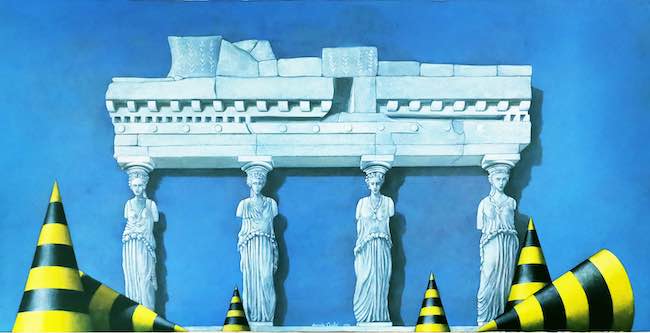Andare oltre il visibile, raccontare di tutte quelle energie che si muovono intorno all’essere umano spesso inconsapevole di trovarsi immerso in un mondo vivo, fatto di una serie di forze impercettibili che ne governano un ordine di cui l’individuo sarebbe solo un elemento della causa e dell’effetto se non fosse per il suo intelletto, per la capacità di fermarsi, ascoltare e riflettere, appartiene a quella categoria di artisti che non riesce a fermarsi alla superficie, né alla pura emozione, bensì ha bisogno di approfondire trovando una terra di mezzo tra sensazione e razionalità, tra osservazione oggettiva e destabilizzazione delle certezze apparenti per spingersi all’interno del senso più profondo delle cose. L’artista di cui vi racconterò oggi mostra fin dagli esordi della sua carriera, questo tipo di attitudine espressiva attraverso la quale riesce a catalizzare l’attenzione dell’osservatore tirandolo letteralmente dentro le sue atmosfere improbabili.
Nel momento in cui emerse in un gruppo di artisti dei primi decenni del Novecento, la necessità di andare a esplorare tutto ciò che si nascondeva all’interno della mente, dell’universo onirico legato a un subconscio troppo a lungo relegato al silenzio, prima a causa del percorso di distacco dalla forma conosciuta e dall’esigenza di sperimentazione del puro plasticismo dell’Astrattismo Geometrico, del De Stijl, del Suprematismo, del Costruttivismo e della Bauhaus e poi per via degli orrori della Prima Guerra Mondiale che aveva tolto agli artisti il desiderio di osservare la realtà intorno a sé, in quel momento dicevo cominciarono a prendere forma le basi di un nuovo stile pittorico che prese il nome di Surrealismo. All’interno del movimento vi furono alcuni autori come Salvador Dalì, Max Ernst e Yves Tanguy che orientarono la loro ricerca verso gli incubi, le inquietudini, le angosce e le ossessioni dell’uomo dell’epoca, partendo dalla ricerca sull’inconscio effettuata da Sigmund Freud sui militari rientrati dalla guerra e affetti da sindrome post-traumatica, mentre altri come i belgi René Magritte e Paul Delvaux preferirono esplorare l’enigma del vivere, l’alternanza tra senso e non senso che apparteneva alla vita di allora tanto quanto a quella attuale e che permetteva proprio in virtù dello sguardo sagace e profondo dei due maestri di andare a fondo di una realtà che aveva bisogno di essere portata alla luce. Ma non si può parlare del Surrealismo Metafisico di René Magritte senza parlare di colui che lo ha ispirato e che è anche considerato il fondatore della Metafisica, Giorgio De Chirico, il quale ha più volte assunto posizioni dissonanti e dure nei confronti degli eccessi del Surrealismo di Dalì, sottolineando quanto invece nell’arte fosse importante l’ordine, quello attraverso il quale sarebbe stato possibile ascoltare il silenzio, riflettere sul senso della realtà, su quelle domande che la sete di conoscenza suscita ma a cui è impossibile trovare risposte; le sue tele sono caratterizzate da un’apparente immobilità fatta di scenari privi della presenza umana, abitati da manichini e statue classiche dove da un momento all’altro tutto può cambiare e assumere una forma differente, stimolando il desiderio di approfondimento ma lasciando socraticamente all’osservatore la possibilità di trovare le proprie interpretazioni.
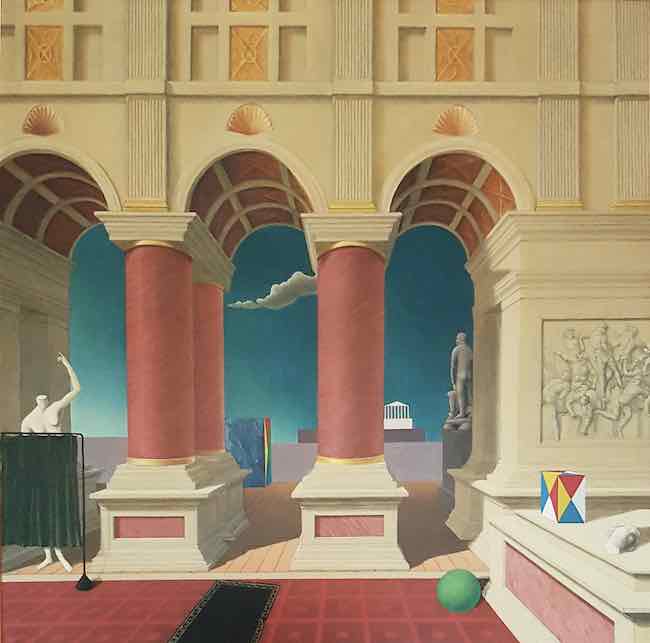
L’artista leccese Donato Carlà mostra una forte vicinanza al maestro della Metafisica, per il suo approccio pittorico limpido e cristallino, che sarebbe di impronta realista se non fosse per quel distacco totale dalla contingenza, per l’introduzione del non senso e della decontestualizzazione degli elementi e degli oggetti con cui associa il passato al presente e con cui sottolinea l’affettività legata al ricordo di un luogo o di cose appartenenti allo scrigno emotivo, e per il sopraggiungere di elementi pratici e pragmatici che sembrano romperne lo schema poetico.
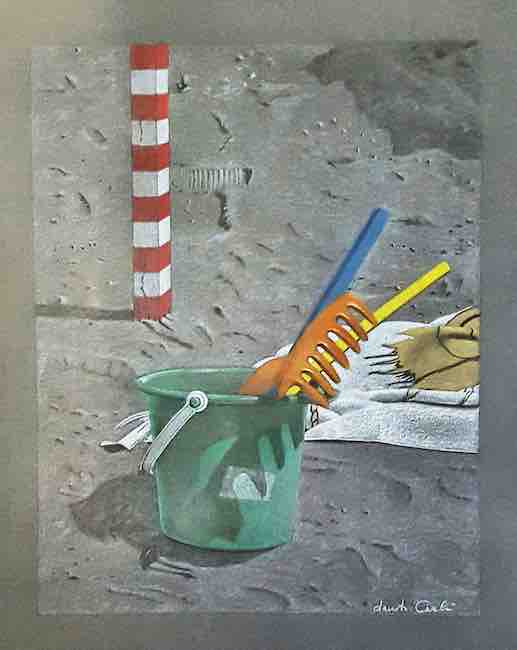
Strumenti edili come i coni in plastica, i pali di limitazione a strisce rosse e bianche, segnalatori, scatole circensi, palloni multicolorati sono introdotti nelle opere come a costituire un fattore di disturbo, un punto di partenza per una meditazione sulla storia dell’uomo, del suo desiderio costantemente manifestato di conoscere un futuro, di risolvere quegli enigmi che hanno appassionato gli studiosi di ogni tempo malgrado nessuno sia mai riuscito a dare una spiegazione universale, perché la realtà è cangiante, sfugge, si trasforma costantemente, e anche perché troppo di frequente l’uomo di ogni epoca trascura di considerare che non tutto può essere controllato, spiegato, scoperto. Piuttosto, sembra suggerire Carlà, sarebbe più saggio accogliere l’idea che alcune risposte non arriveranno mai, il futuro non è conoscibile, mentre tutto ciò che può essere compreso e studiato è il passato, il cammino che ha permesso all’individuo di progredire, arrendendosi al fatto che forse è proprio lo sforzo di ricerca della conoscenza a essere il motore primario della vita e dell’evoluzione.
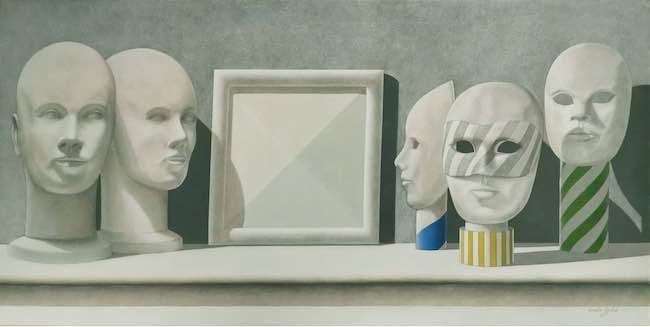
Le atmosfere sono silenziose, suggestive tanto quanto quelle di De Chirico eppure in qualche modo più contemporanee, più metropolitane, più tendenti a proiettarsi nella realtà moderna che viene accolta da Donato Carlà come fondamento irrinunciabile e che non può che fondersi con le conoscenze e gli apprendimenti di un tempo lontano in cui forse l’uomo viveva ritmi più lenti e pertanto più protesi verso la riflessione, l’approfondimento.
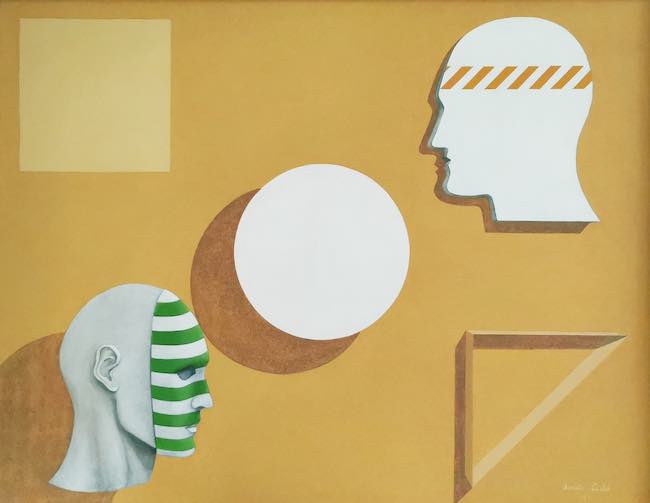
L’elemento del Classicismo si mescola dunque a una rilettura del percorso di assimilazione culturale, meditativo, conoscitivo, rilettura che si mette in dialogo con la parte più inconscia per trasportare l’osservatore in un percorso di consapevolezza, di osservazione più intensa e analitica di ciò che lo ha condotto fino alla fase attuale.
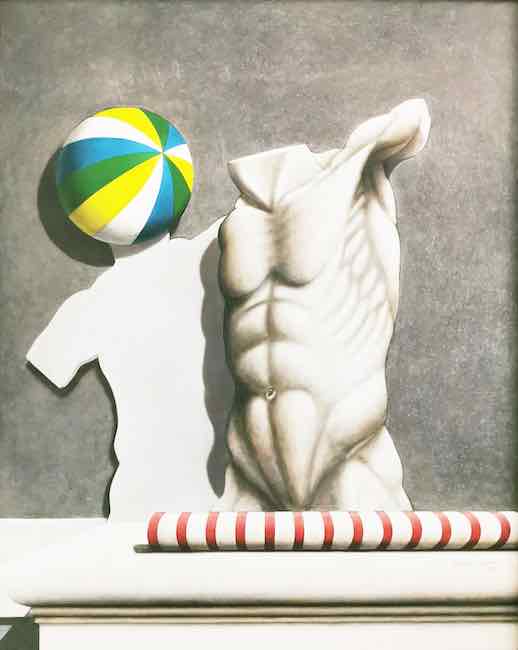
Nella tela Lo scienziato e il filosofo l’artista esamina il differente approccio di due figure entrambe votate alla conoscenza e alla scoperta, il primo attraverso la matematica e i calcoli e dunque il determinismo, il secondo invece in virtù dell’intuizione ma anche dell’apertura alla logica dialettica che gli permette di sovvertire le regole e le equazioni per entrare in un universo che va al di là della fisica, appunto la meta-fisica. Tuttavia emerge il sottile suggerimento della sovrapposizione dei due ruoli osservando il pallone colorato sulla testa del filosofo che induce a riflettere sul differente approccio che però spesso si incontra nel concetto da esplicare o a cui trovare un senso, una spiegazione; non si può pertanto non pensare ad alcune figure che hanno sovvertito gli schemi precedenti scoprendo verità impensate solo attraverso la creatività, quell’estro figlio del coraggio della follia che ha permesso loro di andare al di là di ciò che era predeterminato e osare nuove teorie scoprendo così qualcosa di inconosciuto, sia che si trattasse di filosofi sia che invece fossero scienziati.
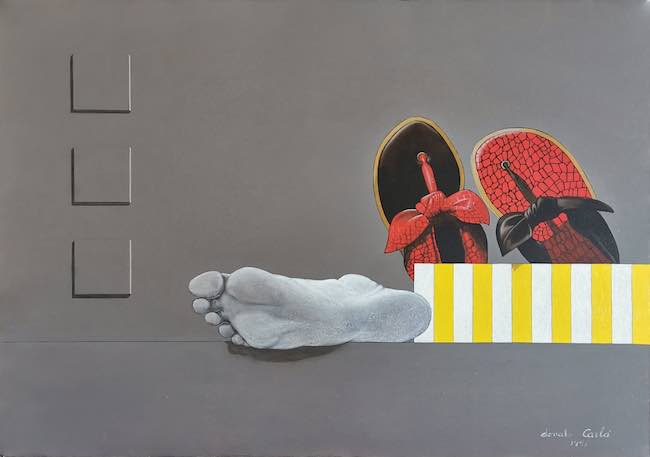
In Circostanza apodittica Carlà gioca con le parole, usando per il titolo dell’opera un termine che indica l’inconfutabilità di un’evidenza, pur di fatto mostrando l’improbabilità dell’immagine protagonista poiché se da un lato è ovvio che le infradito possano essere indiscutibilmente indossate solo dai piedi, dall’altro è quanto meno curioso che a quel piede fortemente reale, a parte la tonalità in scala di grigio, non sia collegata la porzione di gamba che ci si aspetterebbe di vedere. Dunque il messaggio di questo dipinto è che tutto può essere costantemente messo in discussione, persino ciò che fino a un momento prima costituiva una certezza granitica, perché non esistono mai realtà assolute, ogni cosa è in costante trasformazione anche sulla base del punto di osservazione di chi vi si pone davanti.
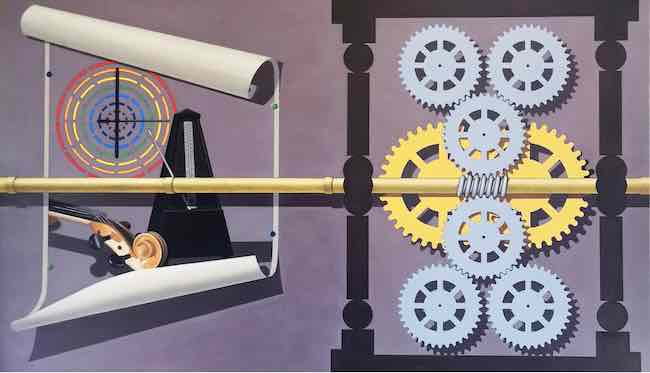
Il tema dell’impossibilità del determinismo emerge anche nel lavoro La temporalità nel tempo in cui Donato Carlà sottolinea quanto il più sfuggente dei concetti, da sempre oggetto di misurazione e di riflessione scientifica e filosofica, di fatto non sia afferrabile, malgrado la tendenza dell’essere umano a volerlo modellare e controllare, egli continua a correre, a non poter essere dilatato o accelerato sulla base del desiderio personale, bensì ha dei suoi meccanismi che sfuggono a quelle misurazioni e ingranaggi che l’uomo utilizza da sempre per calcolarlo. Forse è proprio questo il messaggio che si nasconde negli elementi enigmatici dell’opera, quel memento nei confronti dell’osservatore di non illudersi di essere eterno, di vivere intensamente e al meglio il presente poiché non è possibile aspettarsi che le occasioni e i frammenti che sono stati lasciati indietro possano ripresentarsi. Donato Carlà pur avendo intrapreso gli studi artistici fin da giovane, si è diplomato presso l’Accademia di Belle Arti di Brera e poi ha proseguito il biennio di specializzazione all’Accademia di Lecce, ha seguito una carriera professionale diversa, impegnativa e intensa che tuttavia gli ha permesso di continuare a coltivare la sua passione, quella per la pittura, che tutt’oggi continua ad affascinare appassionati e collezionisti.
DONATO CARLÀ-CONTATTI
Email: donatocarla4@gmail.com
Facebook: https://www.facebook.com/donato.carla.96
Linkedin: https://www.linkedin.com/in/donato-carl%C3%A0-aa415a58/
Instagram: https://www.instagram.com/donato.carla/
Donato Carlà’s enigmatic settings, poised between the past and contemporary reflections
To go beyond the visible, to tell of all those energies that move around the human being who is often unaware that he is immersed in a living world, made up of a series of imperceptible forces that govern an order of which the individual would be only an element of cause and effect were it not for his intellect, his ability to stop, listen and reflect, belongs to that category of artists who cannot stop at the surface, nor at pure emotion, but need to delve deeper, finding a middle ground between sensation and rationality, between objective observation and the destabilisation of apparent certainties in order to push into the deepest sense of things. The artist I am going to tell you about today has been displaying this type of expressive attitude since the beginning of his career, through which he succeeds in catalysing the observer’s attention by literally pulling him into his improbable atmospheres.
At a time when emerged the need in a group of artists of the early decades of the 20th century to go and explore everything that was hidden inside the mind, the oneiric universe linked to a subconscious that had been relegated to silence for too long, first because of the path of detachment from known form and the need to experiment with the pure plasticism of Geometric Abstractionism, of De Stijl, Suprematism, Constructivism and the Bauhaus, and then because of the horrors of the First World War that had deprived artists of the desire to observe the reality around them, at which time began to take shape the foundations of a new style of painting, which took the name Surrealism. Within the movement there were some authors such as Salvador Dali, Max Ernst and Yves Tanguy who directed their research towards the nightmares, anxieties and obsessions of the man of the time, starting from the research on the unconscious carried out by Sigmund Freud on soldiers who had returned from the war and suffered from post-traumatic syndrome, while others, such as the Belgians René Magritte and Paul Delvaux, preferred to explore the enigma of living, the alternation between sense and non-sense that belonged to life then as much as now, and which allowed the two masters’ shrewd and profound gaze to get to the bottom of a reality that needed to be brought to light. However, one cannot speak of René Magritte’s Metaphysical Surrealism without mentioning the one who inspired it and who is also considered the founder of Metaphysical Art, Giorgio De Chirico, who on several occasions took a dissonant and harsh stance towards the excesses of Dali’s Surrealism, emphasising how important in art was order through which it would be possible to listen to silence, to reflect on the meaning of reality, on those questions that the thirst for knowledge arouses but to which it is impossible to find answers; his canvases are characterised by an apparent immobility made up of scenarios devoid of human presence, inhabited by mannequins and classical statues where from one moment to the next everything can change and take on a different form, stimulating the desire for in-depth study but socratically leaving the observer to find his own interpretations.
The Lecce artist Donato Carlà shows a strong closeness to the master of Metaphysics, for his limpid and crystalline pictorial approach, which would be of a realist stamp were it not for that total detachment from contingency, for the introduction of non-sense and the decontextualisation of elements and objects with which he associates the past with the present and with which he emphasises the affectivity linked to the memory of a place or of things belonging to the emotional treasure chest, and for the addition of practical and pragmatic elements that seem to break the poetic pattern. Construction tools such as plastic cones, red and white striped limitation poles, markers, circus boxes, multi-coloured balloons are introduced into the paintings as if to constitute a disturbing factor, a starting point for a meditation on the history of man, of his constantly manifested desire to know a future, of solving those enigmas that have fascinated scholars of all times despite the fact that no one has ever managed to give a universal explanation, because reality is changing, escaping, constantly transforming itself, and also because all too often mankind of all ages neglects to consider that not everything can be controlled, explained, discovered. Rather, Carlà seems to suggest, It would be wiser to embrace the idea that some answers will never come, the future is not knowable, while all that can be understood and studied is the past, the path that has allowed the individual to progress, surrendering to the fact that perhaps it is precisely the effort to seek knowledge that is the primary motor of life and evolution. The atmospheres are silent, as evocative as De Chirico’s and yet somehow more contemporary, more metropolitan, more prone to projecting into modern reality, which Donato Carlà accepts as an inalienable foundation and which cannot but merge with the knowledge and learning of a distant time when perhaps man lived at a slower pace and therefore more inclined towards reflection and in-depth study. The element of Classicism is therefore mixed with a reinterpretation of the walk of cultural, meditative, cognitive assimilation, a reinterpretation that engages in dialogue with the most unconscious part to transport the observer in a path of awareness, of more intense and analytical observation of what has led him to the present stage.
In the canvas The Scientist and the Philosopher, the artist examines the different approach of two figures both devoted to knowledge and discovery, the former through mathematics and calculations and thus determinism, the latter on the other hand by virtue of intuition but also of an openness to dialectical logic that allows him to subvert rules and equations to enter a universe that goes beyond physics, in other words, meta-physics. However, the subtle suggestion of the overlapping of the two roles emerges when observing the coloured ball on the philosopher’s head, leading one to reflect on the different approach often encountered in the concept to be explicated or to find a meaning, an explanation; therefore, one cannot help but think of certain figures who have subverted previous schemes by discovering unthought-of truths only through creativity, that flair born of the courage of madness that allowed them to go beyond what was predetermined and dare new theories, thus discovering something unknown, whether they were philosophers or scientists. In Apodictic circumstance Carlà plays with words, using for the title of the work a term that indicates the irrefutability of an evidence, while in fact showing the improbability of the protagonist image, for while it is obvious that flip-flops can only be unquestionably worn by feet, it is at the very least curious that the portion of the leg one would expect to see is not connected to that strongly real foot, apart from the greyscale hue. Thus, the message of this painting is that everything can be constantly questioned, even that which until a moment before constituted a granitic certainty, because absolute realities never exist, everything is in constant transformation, even on the basis of the observer’s point of view. The theme of the impossibility of determinism also emerges in the painting Temporality over time in which Donato Carlà emphasises how the most elusive of concepts, which has always been the subject of measurement and scientific and philosophical reflection, cannot in fact be grasped, despite the human being’s tendency to want to shape and control it, it continues to run, and cannot be dilated or accelerated on the basis of personal desire, but rather has its own mechanisms that elude those measurements and gears that man has always used to calculate it. Perhaps this is precisely the message hidden in the enigmatic elements of the artwork, that reminder to the observer not to delude himself that he is eternal, to live intensely and to the fullest the present, since it is not possible to expect that the opportunities and fragments that have been left behind can reappear. Although Donato Carlà undertook artistic studies from a young age – he graduated from the Brera Academy of Fine Arts and then went on to complete a two-year specialisation course at the Lecce Academy – he followed a different, demanding and intense professional career that nevertheless allowed him to continue cultivating his passion, that for painting, which continues to fascinate enthusiasts and collectors to this day.


